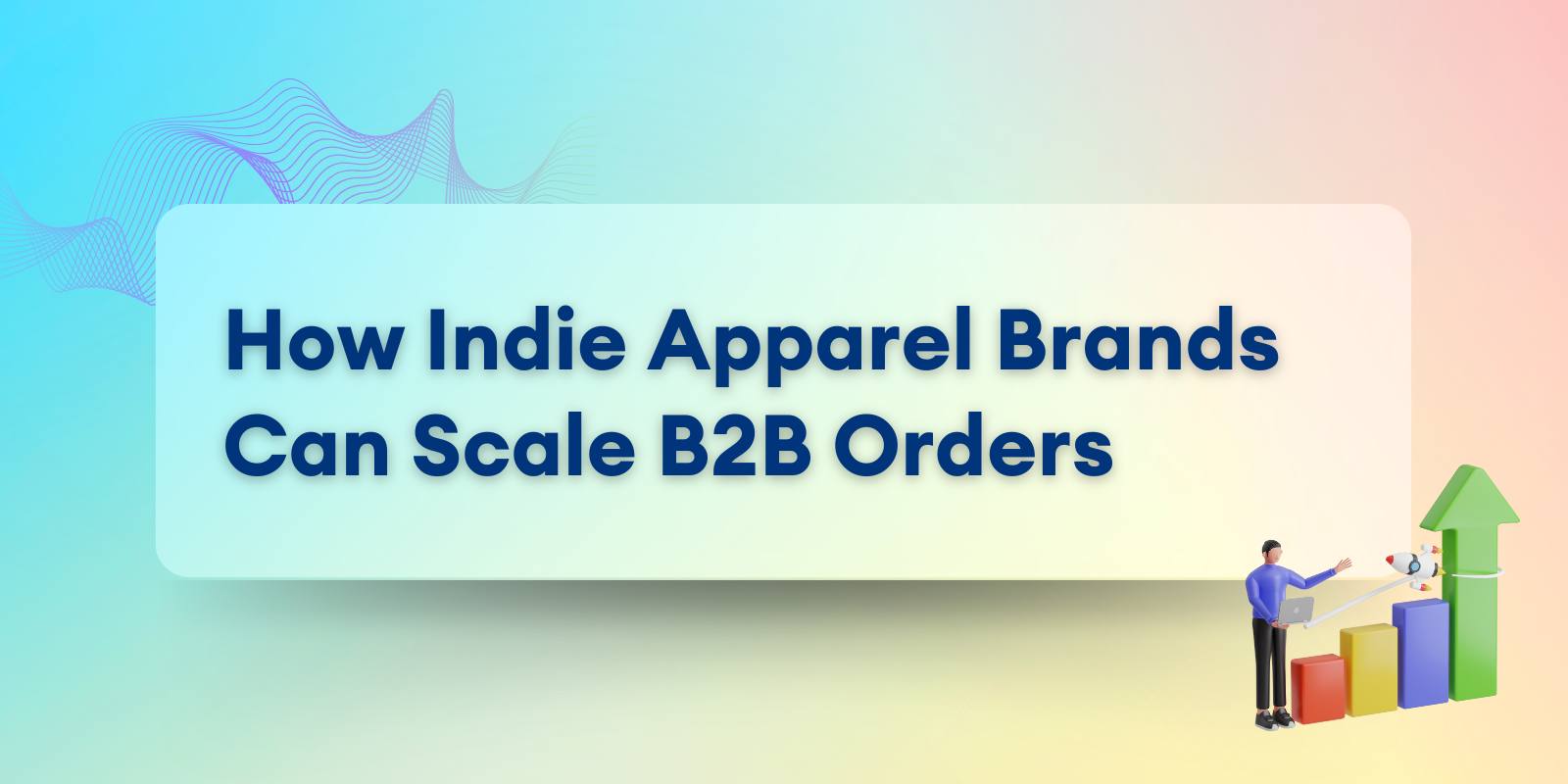
Tuesday, 9:14 a.m. Your Shopify ping lights up: a boutique wants 200 hoodies, wholesale.
Big win, right?
Last time a request this size hit your inbox you spent the night wrestling packing slips, courier portals, and a surprise surcharge that erased half your profit.
Feeling that knot in your stomach yet? Good. Keep reading.
This guide hands you a repeatable carton-to-customer workflow built from no-code tools you already know. You will capture the order, score the lowest label price, schedule pickup, and track every box without adding headcount or learning to code. Calm, predictable shipping, profitable wholesale.
Let’s get to it.
Why B2B Shipping Isn’t Just Bigger B2C
Retailer Routing Guides & Charge-Back Landmines
Selling single tees to fans is simple: print a label, drop at the post office, enjoy the cha-ching.
Wholesale is a different sport. Every retailer sends a routing guide that dictates carton size, label placement, pallet height, even the font on the packing slip. Miss one rule and you trigger a “non-compliance” fee that can swallow the entire order margin. Add seasonal drop deadlines and you get a narrow delivery window with zero wiggle room.
Your takeaway: success in B2B begins with knowing and logging each partner’s logistics rules so your workflow obeys them automatically, not the night before shipment.
Volume, Carton Sizes, and Cost Creep
A direct-to-consumer order might weigh one pound. A boutique reorder of hoodies can hit forty pounds and bump into dimensional weight pricing. Carriers bill by whichever number, weight or size, costs you more.
That is why founders who eyeball carton sizes watch profit evaporate.
You need a right-size box library, a scale, and real-time access to multi-carrier pricing so each shipment uses the cheapest lane.
Volume also amplifies tiny errors. A one-dollar misprint on a single label feels minor.
Repeat it on two hundred cartons and you have a car payment. Precision at scale keeps costs predictable and margins healthy.
How Smart Shipping Services Slash Wholesale Headaches
Price swings, pickup cut-offs, lost cartons; Most logistics pain stems from acting on stale data.
Modern shipping services aggregate live rates from multiple carriers, print labels, book door-to-door pickup, and feed tracking numbers straight into Shopify or Airtable.
Imagine selecting the cheapest lane in two clicks, not fifteen browser tabs. Better yet, the platform remembers each retailer’s routing guide, so your labels and cartons stay compliant by default.
The result: no surprise surcharges, no last-minute depot runs, just predictable margins and retailers who reorder because delivery “just works.” Investing fifteen minutes to plug an aggregator into your stack now saves hours, and hundreds of dollars, on every big PO.
Map Your End-to-End Carton Workflow
Order Capture and “Wholesale-PO” Tagging
Start where the money lands: your store or order form.
In Shopify or WooCommerce, set an “Wholesale-PO” tag that fires whenever a customer selects the B2B price list or enters a purchase-order number.
That tiny tag is the key that triggers every downstream step automatically: it feeds your spreadsheet, populates pick lists, and cues the label printer.
No more copying data by hand, no more “Did we tag that?” anxiety.
One click, full visibility.
Pick-and-Pack Station Setup
Move to the packing table.
Lay out SKUs left-to-right, smallest to largest.
Place a USB barcode scanner beside a simple checklist on an iPad or cheap Chromebook.
Scan each garment as it drops into the carton; the sheet ticks it green, flashes red if anything is missing.
Close the box, apply a pre-printed retailer label, and slide the carton to the “Ready for Label” stack.
You just eliminated mis-picks and late-night recounts without hiring extra hands.
Rate Shopping and Label Print
Now launch your aggregator dashboard. The PO tag pushes carton dimensions and weight straight into the rate-shopping view.
In seconds you see a side-by-side price grid from every major carrier plus regional specialists.
Filter by delivery date, click the cheapest option that still hits the retailer’s window, and hit “Buy label.” The system saves the tracking number to your order record, emails it to the boutique, and spits out a thermal label ready for the box.
You still have coffee in your cup, yet the most expensive part of fulfillment is already optimised.
Repeat for each carton or bulk-select all and print a stack of labels at once.
Door-to-Door Pickup Scheduling and Live Tracking
Labels printed, cartons stacked, time to move them. In the same dashboard, pick a pickup slot; tomorrow morning before 11 a.m. beats the afternoon cutoff every time. Confirm the driver, click “Schedule,” and a pickup manifest prints automatically. Tape it to the lead carton, high-five yourself, and leave the building on time. Once the driver scans the boxes, tracking updates flow to the retailer, your Slack channel, and the Airtable dashboard.
No more “Where’s my shipment?” emails. You see delays in real time and can nudge the carrier before the boutique notices.
Case in point: Threaded Tees
Last quarter this two-person streetwear label plugged the exact workflow above into Shopify and Airtable.
Result: average carton cost dropped 18 percent, delivery SLA jumped to 97 percent on-time, and reorders doubled within six weeks. The founders now pack twice the volume without weekend shifts, proving lean processes beat brute force every time.
Build a 100 Percent No-Code Shipping Stack
Shopify or WooCommerce to Zapier, Step by Step
- Trigger: “New Order” with the Wholesale-PO tag.
- Filter: Only pass orders whose weight exceeds one pound or contain more than five units, so samples stay manual.
- Action: “Create Shipment” in your aggregator account; the zap pushes weight, size, and retailer address.
- Action: “Generate Label PDF” and store the link in the order notes.
- Action: “Send Slack Message” to #ops-today with order number, carrier, and pickup time.
- Action: “Add Row” to Airtable Ship_Log with cost, chosen lane, and promised delivery date.
Result: every wholesale order gets a label, pickup slot, and internal heads-up within thirty seconds. No copy-paste, no forgotten cartons, and the cost data lands where you can analyse it later.
Airtable KPI Dashboard in Twenty Minutes
- Base structure: Ship_Log (one row per carton), Retailers, and Rates.
- Formulas:
- Cost_per_lb = Total_Cost ÷ Weight
- On_Time = IF({Delivered_Date} ≤ {Promise_Date}, 1, 0)
- Interface: Drag a bar chart for Average Cost per Carton and a gauge for On-Time Percentage.
- Automation: When On_Time drops below 96 percent, Airtable emails you and pings the carrier rep.
- Glossary call-out:
- Cost per Carton: total label plus surcharge divided by cartons shipped.
- On-Time Percentage: cartons delivered on or before the promise date, divided by total cartons.
- Dim Weight: price based on size when it costs the carrier more than the literal weight.
With these two views you know, at a glance, whether the workflow you built is saving or devouring margin and can fix leaks before they sink your profit.
Keep Costs Under Control
Multi-Carrier Strategy: Save 10 to 25 Percent per Carton
Locking yourself into one carrier is like buying airline tickets from the first search result every time.
Pull live quotes from national and regional couriers on every order instead.
An aggregator dashboard shows that a 35-pound hoodie carton from Toronto to Chicago costs 18 USD with Carrier A but 24 USD with Carrier B the same morning.
Multiply that six-dollar gap by forty cartons and you keep two hundred forty dollars.
Set a quarterly calendar reminder to audit average rates and fuel surcharges; if a lane creeps higher than last quarter, switch carriers before the hike eats your margin.
Packaging Tweaks to Dodge Dimensional Weight Fees
Carriers price by whichever is greater: actual weight or dimensional weight. A half-empty box inflates size and cost.
Combat this with a library of right-size cartons, poly-mailer inserts, and simple vacuum bags for bulkier items like hoodies.
Use a box-sizer tool to trim excess height on partly filled cartons; cutting three inches can drop the billable weight bracket. Keep filler light and recycled: crumpled kraft paper beats plastic air pillows for both cost and sustainability points with retailers. Track Cost per Carton each week; if it climbs without a volume jump, review your box choices first.
Packaging & Compliance 101
Right-Size Cartons and Eco Fillers
Ship garments, not air.
Measure your folded stack, grab the smallest carton that still fits, and line it with plain kraft paper. This trim keeps dim weight low and scores eco points with retailers.
Use a box-sizer or carton-scorer to shave tall boxes down to garment height. A single inch sliced off forty cartons equals real postage savings. Finish with water-activated paper tape: strong seal, recyclable, and no plastic guilt.
Cross-Border Docs, HS Codes, and Insurance Basics
Crossing borders? Fill out the commercial invoice inside your aggregator dashboard, pull the correct Harmonized System code for apparel (usually 6109.90 for cotton tees), and declare cost of goods, not retail price.
Add low-cost shipment insurance inside the same portal. If customs misplaces a carton, you file the claim online and recoup the wholesale value without drama. Attach invoices in a clear sleeve on the lead carton so customs officers can scan and go. Less paperwork hassle, quicker clearance.
Scale From 20 to 200 Cartons Per Month Without New Staff
Batch Automation and KPI Thresholds
When orders jump, click the “bulk-select” box in your shipping dashboard, generate labels for every carton in one run, and print the manifest last.
Let Zapier copy each tracking number to Airtable so On_Time metrics update without typing.
Flag two danger lines: Cost per Carton higher than fifteen dollars or On-Time Percentage lower than ninety-six percent. If either trips, investigate that lane before it drains profit.
When a 3PL Finally Makes Sense
If weekly volume pushes you past fifty labor hours or if cartons occupy half your living space, price out a local third-party logistics partner. Compare total pick-pack-ship cost versus your current cost per carton, including your own wage at twenty dollars per hour. If the 3PL beats your blended cost and matches your on-time goal, outsource the grunt work and keep strategy in-house.
Pro Tips and Common Pitfalls
Skip Afternoon Pickups
Late-day collections often miss the line-haul truck, adding a calendar day before transit even starts. Book a morning window; cartons leave the depot that night and you win a built-in buffer if weather or customs slows things later.
ASN Compliance Checklist
Many retailers demand an Advance Shipment Notice. Inside Shopify, add a flow that emails the ASN template once the label prints. Include carton count, SKU list, and PRO number. Miss any field and you risk a non-compliance fee. Automate it once, avoid fines forever.
In Conclusion
Wholesale orders should feel like growth, not roulette.
Tag the order, scan the garment, pick the cheapest lane, and watch cartons arrive on time.
The lean workflow above turns shipping from profit leak into brand advantage, and you build it with off-the-shelf tools, not code.
Prepare the checklist, wire up the zap, and put your next big PO on autopilot so you can get back to designing the line your customers actually wear.




